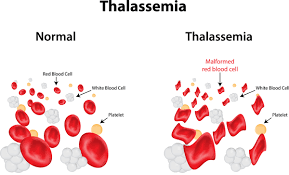Thalassemia is a genetic blood disorder. People with Thalassemia disease are not able to make enough hemoglobin, which causes severe anemia. Hemoglobin is found in red blood cells and carries oxygen to all parts of the body. When there is not enough hemoglobin in the red blood cells, oxygen cannot get to all parts of the body. Organs then become starved for oxygen and are unable to function properly.
There are two primary types of Thalassemia disease: Alpha Thalassemia disease and Beta Thalassemia disease. Beta Thalassemia Major (also called Cooley’s Anemia) is a serious illness.
Sign and symptoms:
The symptoms of thalassemia vary depending on the type of thalassemia.
Symptoms will not show until the age of 6 months in most infants with beta thalassemia and some types of alpha thalassemia. This is because neonates have a different type of hemoglobin, called fetal hemoglobin.
After 6 months “normal” hemoglobin starts replacing the fetal type, and symptoms may begin to appear.
These include:
- jaundice and pale skin
- drowsiness and fatigue
- chest pain
- cold hands and feet
- shortness of breath
- leg cramps
- rapid heart beat
- poor feeding
- delayed growth
- headaches
- dizziness and faintness
- greater susceptibility to infections
- Skeletal deformities may result as the body tries to produce more bone marrow.
Effects on other organs:
If there is too much iron, the body will try to absorb more iron to compensate. Iron may also accumulate from blood transfusions. Excessive iron can harm the spleen, heart, and liver.
Patients with hemoglobin H are more likely to develop gallstones and an enlarged spleen.
Untreated, the complications of thalassemia can lead to organ failure.
🔥27 Views





